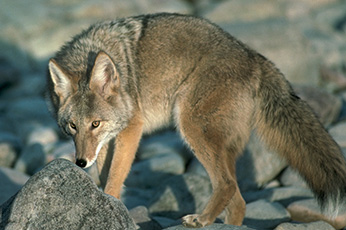Announcements
- Homepage
- Communications
- Announcements
- Suburban Wildlife: Tips for Peaceful ...
Ladera Ranch has many wildlife species that can thrive when living near people. Animals such as skunks, opossums, raccoons, gray fox, red fox, coyotes are relatively common for our area.
Everything these species do is related to the availability of food. They are attracted to human landscapes because they are highly adaptable and opportunistic feeders. They can easily adjust to changes in their environment and eat a variety of plant and animal materials, including food left around by people. These animals learn quickly that, when given the choice between a meal that has to be chased and one that is easily found in a backyard, they will always pick the easy meal.
Many species actually cohabitate with people and move right into homes and other structures. Raccoons, bats and all types of squirrels are constantly searching out their surrounding for new habitats and will move into uncapped chimneys or attics with old or rotted trim boards or unprotected venting systems. Ground dwelling animals will burrow under porches, sheds and into crawl spaces.
Here are some simple rules that will help your surrounding become less attractive to unwanted wildlife species and may prevent conflicts with wildlife from occurring.
1. Don’t feed wildlife!
Direct feeding can alter an animal’s normal behavior. Problems occur when animals become reliant on humans through prolonged periods of direct and/or indirect feeding.
2. Don’t approach wildlife!
Don’t provoke an encounter by moving too close or trying to pet a wild animal, or by restricting its free movement.
3. Keep all trash around your yard contained and picked up.
Many wildlife species are most active at night. Do not put your trash out for pick up the next day unless it is in a sealed container that wildlife cannot penetrate.
4. Keep compost in a container
Containers should allow the material to vent but keeps wildlife out.
5. Do not feed pets outdoors.
This can attract wildlife right to your door.
6. Secure your pets.
Although free roaming pets are more likely to be killed by automobiles than by wild animals, there are wildlife species like coyotes that view cats as potential prey and dogs as competition for mates and food. For the safety of pets, keep them restrained at all times.
7. Remove bird feeders if problem wildlife species are seen around the feeders.
The seed in birdfeeders can attract many small and medium sized mammals. These animals in turn attract species that prey on squirrels, chipmunks, mice, etc.
8. Close off crawl spaces under porches and sheds.
Wildlife will use these areas as dens for resting and raising their young. Also, keep your structure and chimney in good repair.
9. Protect livestock and produce.
Wildlife species will prey upon livestock. There are techniques for protecting livestock from predation; e.g., fencing can be useful in keeping wildlife out of certain areas. Clear fallen fruit from around fruit trees in the fall to reduce attracting wildlife species.
10. Make it a community effort and share helpful information with your neighbors.
Your own good efforts could be futile if you have neighbors who are purposely or unintentionally providing food or shelter for wildlife. Wildlife species that thrive in suburban environments are among the most adaptable and interesting of animals. Inevitably there are occasions when conflicts arise.
 Coyotes
Coyotes
Coyotes nest in late winter and begin preparing their den for pups in early spring. This is likely why residents may see more activity.
LARMAC does not trap/relocate or euthanize coyotes. The focus is on education to better understand coyote behavior and be better equipped to coexist with coyotes. Below are several links to additional resources.
Keep Me Wild: Coyote
Additionally, there’s an ongoing research project, being conducted by University of California Cooperative Extension, to collect information on coyote encounters in California. The link to the site is below. You can view where coyote sightings are being reported and also report a sighting yourself.
Coyote Catcher
Coyote Cacher is part of a research project with the University of California Cooperative Extension that aims to collect more information on coyote encounters in California. The information you provide will be used to help inform researchers of trends in human-coyote interactions.
